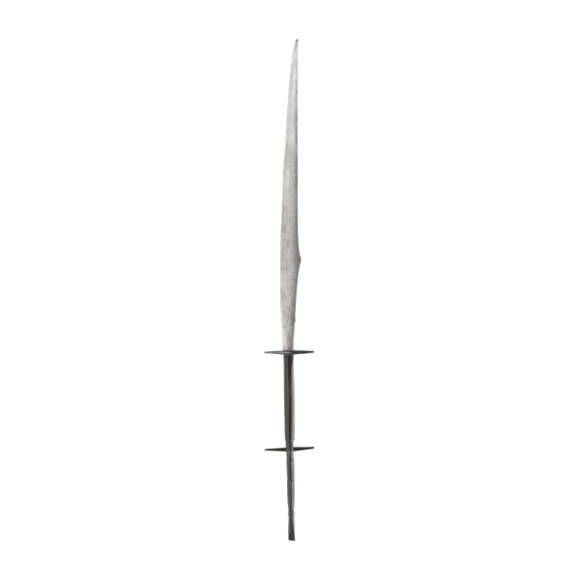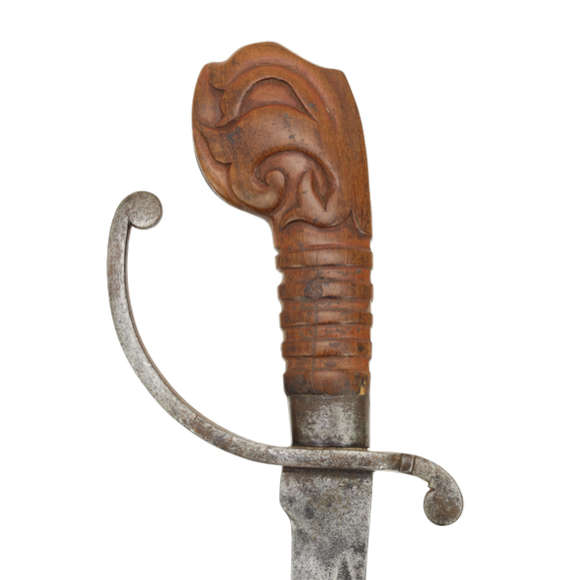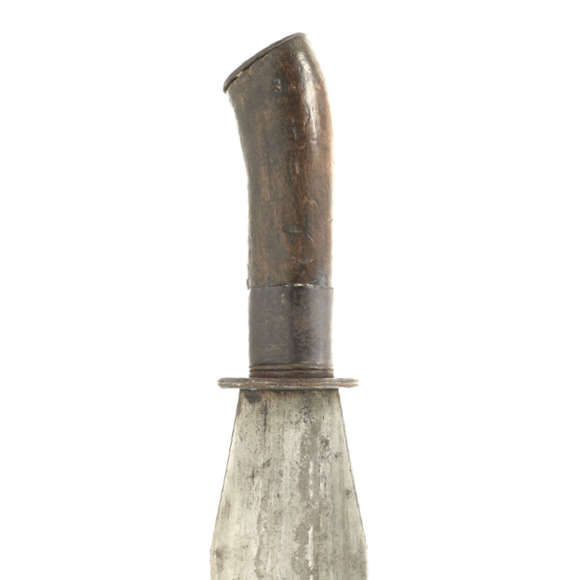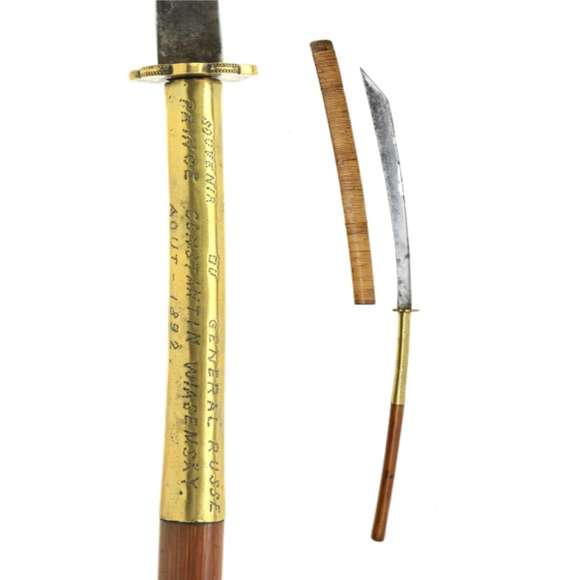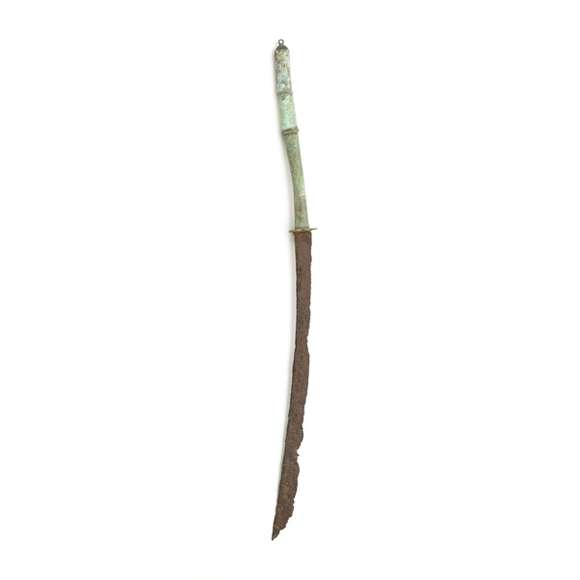Language: Collector's term, Khasi name waitsum
Source: First depicted in 1847
Description
The Khasi dao is a peculiar type of two-handed, single-edged sword with all-steel construction and double crossguards. It is named after the Khasi people of the Khasi hills but was in wider use in the region.
The general Khasi word for sword is waitlam and these swords were known as waitsum, literally "spear sword".1
Similar swords have been observed in use by the Ao Nagas as part of a larger group of archaic large sword forms used in ceremonies.2

A typical example.
Mandarin Mansion inventory 2022.
The first depiction of one, that I am aware of, appears in the 1847 book Sketch of Assam.

From Sketch of Assam, page 184.
Cosseah is an older name for Khasia.
Similar blade of the Tang dynasty
The blade shape appears as early as the Tang dynasty, carried by tribute bearers of unknown origin.

Yan Liben (?-673), early Tang dynasty.
Tribute bearers to the Tang court, probably of the missions of 631 A.D.
Handscroll, ink and colors on silk, 61 x 191 cm.
National Palace Museum, Taiwan.
Use
By the time foreign observers encountered them, they had already fallen out of practical use and were passed down as heirlooms in wealthy families.
Among the Ao Nagas, the swords only came out only three times a year, during sacrificial ceremonies for good harvest where a mithan, a forest-dwelling buffalo, was sacrificed to the Gods. A pair of these swords were put in the ground upright during the ceremony, and it was considered a bad omen if one of them toppled over.3
The Lotha Naga use the term yanthang for a group of large antiquated swords used for the same ritual purposes.4
Notes
1. U. Nissor Singh; English Khasi Dictionary. Shillong, Eastern Bengal and Assam Secretariat Press. 1906. Page 245. Waitsum comes from Valentine Banehskhem Sohtun, a Khasi tribal from Meghalaya, India. Personal communication.
2. Philip S. Rawson; The Indian Sword. London, Herbert Jenkins. 1968. Page 62. Rawson also attributes the weapon to the Lotha Nagas, the Mikirs, and the Bodo but following his footnotes, I did not see this confirmed. The Lotha for example do use large, antiquated dao for ceremonies but they are of a distinctly different type. See the relevant pages for; Lotha, Mikirs, and Bodo.
3. James Philip Mills; The Ao Nagas. Macmillan, London. 1926. Page 61.
4. James Philip Mills; The Lhota Nagas. Macmillan, London. 1922. Pages 16-17.
In the literature
"These arms of the Khasi-Jyntia tribes are as peculiar as their language.
"The tiny family of Khasi is like an island in the midst of the Tibeto-Burman Sea." - (Robt. Cust, Languages of the E. Indies, p.4.)." 1
-Lord Egerton of Tatton, 1880
"The weapons of the Khasis are swords, spears, bows and arrows, and a circular shield which was used formerly for purposes of defence. The swords are usually of wrought iron, occasionally of steel, and are forged in the local smithies. The Khasi sword is of considerable length, and possesses the peculiarity of not having a handle of different material from that which is used for the blade. In the Khasi sword the handle is never made of wood or bone, or of anything except iron or steel, the result being that the sword is most awkward to hold, and could never have been of much use as a weapon of offence." 2
-Major Philip Richard Thornhagh Gurdon, 1907
Describing their use among the Ao Nagas of Mokokchung:
"Besides these "daos", examples of which are still to be seen from time to time, there are kept in the houses of a few rich men ancient long "daos" (noklang C and M) of unknown origin, which are handed down as heirlooms.
These may be divided into three types, all alike having very long tangs which must have passed right through the haft, so that the "dao" could be stuck upright in the ground. Indeed it is in this way that they are displayed at mithan sacrifices, the only time, apparently, when they are brought out of the house." 3
-James Philip Mills, 1926
Notes to literature
1. Lord Egerton of Tatton; Indian and Oriental Arms and Armour. Dover Publications; Revised edition, 2002. Page 84, fig 19, number 204. Description on page 90.
2. Major Philip Richard Thornhagh Gurdon; The Khasis. Macmillan, London. 1907. Pages 23-24.
3. James Philip Mills; The Ao Nagas. Macmillan, London. 1926. Page 60.
Notable examples in museums
Victoria & Albert Museum
The example illustrated in Egerton's was acquired by him in 1869 according to the catalog entry. It was originally in the India Museum, transferred to the South Kensington Museum in 1879. Now held in the Victoria & Albert Museum, accession number 1687(IS).
Also in the V&A are:
1687(IS), transferred from the India Museum in 1879.
2893(IS), acquired by Egerton in 1869. transferred from the India Museum in 1879.
330-1875, published in Philip S. Rawson; The Indian Sword. London, Herbert Jenkins. 1968. Page 62-5, fig.35.
331-1875, slightly different variety with curved through blade and tang. A similar type is illustrated in James Philip Mills; The Ao Nagas. Macmillan, London. 1926. Page 60.
British Museum, London
As1944,01.42, forward curved variety. Donated by the Wellcome Institute for the History of Medicine in 1944.
Metropolitan Museum, New York
Previously in the collection of George Cameron Stone, bequeathed to the Metropolitan Museum in 1936. Accession numbers 36.25.1356 (with photo) and 36.25.1357 (no photo).
Both were published in George Cameron Stone's; A Glossary of the Construction, Decoration and Use of Arms and Armor in All Countries and in All Times, Together with Some Closely Related Subjects. Portland. Southworth Press, 1934. Page 643, fig. 818, 4.
IFICAH
Khasi dao, part of the exhibition on headhunter culture titled "You can leave your head on".
Williamson Sangma State Museum, Shillong, Meghalaya, India
A number of Khasi dao on display with two Garo milam swords.

